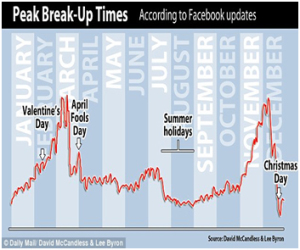 Relationship breakups often are often part of a negative relationship pattern. Research suggests that a couple days after Valentine’s Day is the most popular time for relationship breakups to occur according to Facebook status changes.
Relationship breakups often are often part of a negative relationship pattern. Research suggests that a couple days after Valentine’s Day is the most popular time for relationship breakups to occur according to Facebook status changes.
This research feels accurate as I have the most website visits during the month of February (according to my Google analytics) and new client phone calls. Coincidence? Maybe. Nonetheless, during this time (February) many of my clients describe disappointment, sadness and confusion as they try to understand and mend a broken heart from a breakup.
Although it is interesting to speculate on the pattern of when breakups occur, I believe it is more relevant to understand why people keep repeating negative relationship patterns. I have some explanations drawing from clinical anecdotes, psychological theory and research.
Spotting Negative Relationship Patterns Like Breakups
- The negative perception pattern – One’s perception of the world can influence others. Studies indicate that people who are prone to perceiving others as rejecting, have romantic partners who are more dissatisfied (Downey & Feldman, 1996). Their insecurity creates a self-fulfilling prophecy. Fearing and anticipating rejection often makes rejection prone individuals more jealous, controlling or hostile towards their partners. Consequently, this may cause their partners to breakup, validating their fears.
- Partner selection patterns —
(A) Research and psychoanalytic theory suggest people have a relationship pattern of selecting partners that resemble opposite sex parents (Wilson & Barrett, 1987). It is also not uncommon for people to repeatedly pick partners as an attempt to undo traumas or disappointments from their past with parents, family members or peers. For example, a person whose parent rejected him or her may unwittingly find himself or herself attracted to an indifferent partner. Winning the approval of an indifferent partner may symbolically also represent winning the approval of their distant parent.
(B) Another negative relationship pattern is when individuals are unaware of the similarities their current partners have to previous ones. They may idealize certain positive traits while minimizing negative ones. Not until later in the relationship will the negative traits and red flags about their partners that they dismissed come to the forefront.
(C) There are some individuals who are very aware of their partner’s issues or problems as another negative relationship pattern. The individual may be prone to picking people with flaws and are drawn to the challenge of dating someone with problematic traits. For example, the fantasy of rescuing someone who may be promiscuous or have a drinking problem, may make the individual feel special and unique. - Difficulties being alone setting a negative relationship pattern – Difficulty tolerating being alone may lead someone to engage in relationships with less discretion. This can lead to them to get involved with someone who may be not suitable to avoid being alone. A person may minimize being treated poorly because not having someone in his or her life may be intolerable. Holding on to a negative relationship due to fear of being alone, ultimately, can be very problematic and cause someone to continually find themselves in negative relationships with a breakup pattern.
Psychotherapy can be helpful in helping people understand and break negative relationship patterns and breakup patterns. Sometimes similar dynamics that occur in a person’s relationship world can occur in the therapy relationship.
References:
Downey, G., & Feldman, S (1996). Implications of rejection sensitivity for intimate relationships. Journal of Personality and Social Psychology, Vol 79, No 6, 1327-1343.
Wilson, D, G., & Barrett, T, P (1987) Parental characteristic and partner choice: some evidence for Oedipal imprinting. Journal of Biosocial Science, Vol 19, Issue 2, 157 -161
